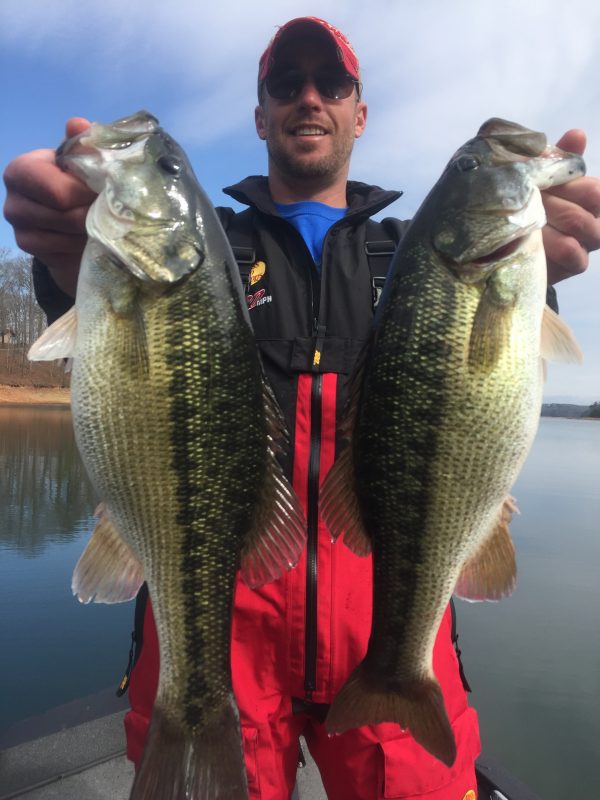by Jimbo Mathley

Optimal Conditions: There are a few things to consider when you begin fishing during this time of year. The largemouth in the lake will physically go on the bed at water temperatures of 58-60 degrees. The spotted bass tend to spawn a bit later when the water temperatures reach 62 degrees or above. Typically, the fish spawn in “waves”, rather than all at once. After the first wave of fish completes their spawning routine, there will be fish in all stages of the spawn (pre, spawn, and post) for the next 30 – 45 days, depending on the weather conditions and water temperatures. Further, it is important to understand that many fish that spawn in waves do so during a favorable moon phase, given the noted water temperature requirements are met. The full and new moon phases often prompt fish to move into their spawning routine. Until those conditions are met, fish will be staging and feeding up in preparation for this process. So, where do we need to look?
Location: The largemouth in Lake Lanier tend to spawn shallower than do the spotted bass. The largemouth can be found bedding in creek pockets, in a protected area, often in 3 feet of water or less. With the water low this year, these fish won’t be in the same places you found them last year, because those places are dry! Look around repositioned docks in shallow water for these fish as well as stumps that were previously in the 12 foot range and are now visible in 2 feet of water or so. The spotted bass can frequently be found in similar areas, but often prefer a hard bottom type area, such as a clay flat can provide. Again, the spots will typically be found in 6-15 feet of water and even deeper. Unlike most largemouth, there are a contingency of the spotted bass that will spawn on the main lake. These fish can be found on or around humps, points and sandy saddles between islands on the main lake. Until the time when the fish spawn in these areas, fish key features adjacent to these spawning areas. Secondary points and docks often provide great staging areas for these fish and become a prime target this time of year. The low water should not affect the spotted bass spawn as much as it will the largemouth spawn. The spots will still be in the same types of places to spawn and will stage in similar areas as well, just not the same places they did last year!
Lures and Presentation: Now that we have explored the location that fish can be found during the spawn, let’s examine some of the techniques and lures that can be used to catch these fish.
- Jerkbaits – A great choice as the water warms out of the 40’s and into the 50’s. Work these baits around docks, points and over humps. A SPRO McStick is a good option. Experiment with cadence to find the right retrieve speed and pause cycle. The colder the water, the longer the pause.
- SuperSpin – This bait from SuperFish Baits in the ¼ ounce size is an excellent choice to work in shallow creek ditches as well as in and around secondary points and docks. Experiment with trailer size and type. Either a Super Fluke Jr. or a boot-tail type trailer such as a Zoom Swimming Fluke are good places to start.
- Crankbait – Excellent choice to cover water in the back of creeks and pockets as well as around secondary point, docks and flats. Try the SPRO Little John Series in varying depth ranges and at variable speeds until you find the best one for the day’s conditions.
- Worm/Jig – Always an option in the springtime. A Chattahoochee Jig on rocky/clay secondary points and around docks is always a good choice for spots or largemouth. If the fish are ultra-finicky, don’t forget the old Carolina rig to present your soft-plastics. Drag or drift this rig slowly over secondary points or spawning flats for some potentially awesome results. Also, when fishing a Picasso Shake Down and worm combo, consider using a lighter jig-head. I often choose a 1/8 ounce head or lighter to target spawning fish. I will often tip this with a 4 inch worm as opposed to a traditional offering of 6 inches or more. I often work the baits slowly in this situation to trigger strikes.
While the winter to spring/early spawn can be a challenging time of year to catch fish, it can be awesome if you remain versatile and open-minded in your approach. Use the tips and techniques noted above to guide your fishing during the spawn and you will enjoy some great success. See you on the water!
Jimbo is a full-time, year-round spotted bass guide on Lake Lanier. Contact him today to book a trip at 770-542-7764 or at www.jimboonlanier.com.

